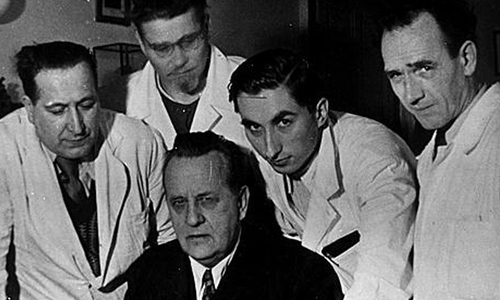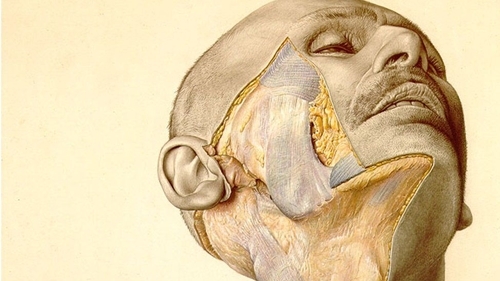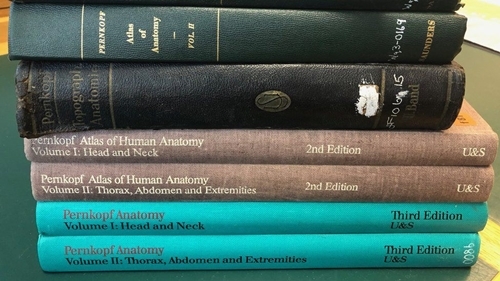A series of pictures of anatomy with a dark past in Nazi Germany
Pernkop Human Anatomy is very useful for doctors, but behind it is the bloody past of Nazi Germany.
When neurosurgeon Susan Mackinnon from Washington University in St. Louis needed help completing a surgery, she pulled out a book on anatomy from the mid-20th century.
Thanks to illustrations showing the human body in layers, Mackinnon successfully completed the surgery. The book she uses is the 4-volume Pernkopf Human Anatomy Picture Series, often called Atlas of Pernkopf. It is considered by many to be the best anatomy in the world, more specific and vivid than any other book.

Skin, muscles, tendons, nerves, organs and bones are shown in detail. This book is not for the faint of heart.
However, it is no longer published, used books are sold for thousands of dollars online. Although the book is valuable, few people display it in their clinics, libraries or homes, as the drawings in the book are based on the dissection of the bodies of hundreds of people killed by Nazi fascists.
Many scientists consider ethical issues when using it. Dr. Mackinnon said that she felt uncomfortable with the origins of the painting but emphasized that it could help her save people and to do so was a "moral surgeon".
Rabbi Joseph Polak, medical law professor who survived the Holocaust Jewish genocide, called the book a "moral mystery" because it originated from "real crime, but can be used to serve good things ".
The book is a 20-year project by Dr. Eduard Pernkopf, who rose rapidly among the academic ranks in Austria thanks to the support of the party of German fascist Adolf Hitler in World War II. Since 1938, Pernkopf always wore a Nazi uniform whenever he went to work. When he was dean of the faculty at the University of Vienna, he fired all Jewish scholars in the department, including three Nobel laureates.
In 1939, Nazi Germany ruled that all bodies of the executed prisoners were immediately taken to the nearest anatomy for research and teaching purposes. Pernkopf spent 18 hours a day dissecting corpses for a group of painters to draw.

Dr. Sabine Hildebrandt, from Harvard Medical School, said at least half of the 800 images of the series were from the bodies of political prisoners, including gay people, Cambodians, political activists and Jews.
Pernkopf was arrested after World War II ended and was fired from university. He was held in an Allied prison for three years but was not charged. After his release, he returned to the university, continued to produce books, and died in 1955.
In the 1937 book release, illustrators Erich Lepier and Karl Endtresser also incorporated the fascist symbol into their signatures. The two-volume English version published in 1964 also has this signature. Later versions deleted the Nazi symbol. Thousands of copies of the book are sold around the world and translated into 5 languages. The introduction describes it as "dramatic paintings" that do not mention the bloody past.
It was not until the 1990s that students and scholars began to question who are the bodies depicted in the book. After the brutal history was revealed, the book was discontinued in 1994. The Royal British College of Surgery said the material was not used in the UK but was stored in a library.

However, a recent survey of neurosurgeons found that 59% of respondents know about Pernkopf's book, 13% are using it. 69% said they were comfortable using the book despite knowing its history, 15% were uncomfortable and 17% did not respond.
Dr. Mackinnon said no document could match the accuracy and detail of the painting. It is especially useful for complicated surgeries because it helps her "identify which of the many nerves running around our body causes pain". However, Mackinnon insists she always makes sure the people involved in the surgery know about the book's dark origins.
Dr. Jonathan Ives, a bioethicist (research on ethical issues emerging from advances in biology and medicine) from the University of Bristol, agrees that the set is "surprisingly detailed." but stressed that it is tainted with a "horrific past".
"If we use it and reap its benefits, it feels like we are 'accomplices," he said. "But you can also argue that if not used, the painting will be forgotten and it cannot remind us of what happened."
Last year, Rabbi Polak and medical historian and psychiatrist Michael Grodin studied and concluded that most Jewish authorities allowed the painting to be used to save lives, provided that those involved. to the healing process informed about its history.
"Look at Dr. Mackinnon's case. She couldn't identify a nerve even though she was the best in the industry. The patient told her 'I want to amputate my leg if she can't find it. 'No one wants that to happen, "Polak said.
"So Mackinnon had to use Pernkopf documents. She found nerves in minutes thanks to the drawings," he added. "She asked me about the ethical aspects of this situation. I replied that if the book could help heal patients and give them back their lives, there was no reason it was forbidden to use it."
FIDITOUR TRAVEL COMMUNICATION COMPANY
Representative: Mr. Tran Van Long - Chairman and General Director
Head office: 95B-97-99 Tran Hung Dao, District 1, City. Ho Chi Minh.
Hanoi Branch: 66 Tran Hung Dao, Hoan Kiem District, Hanoi
Phone: 028 730 56789 | Hotline: 19001177